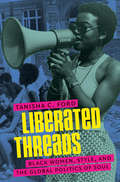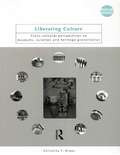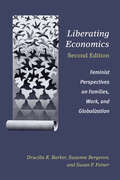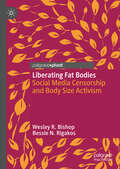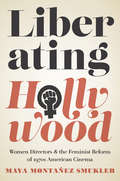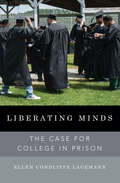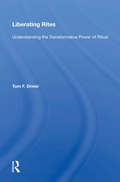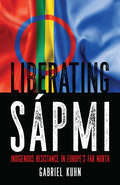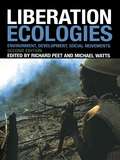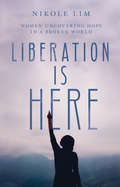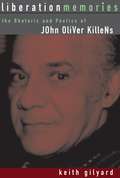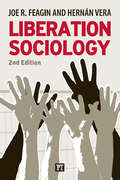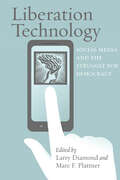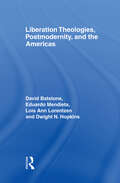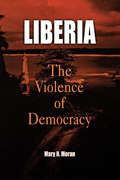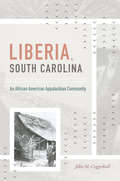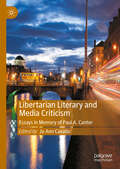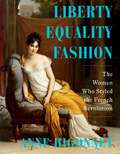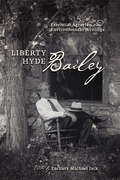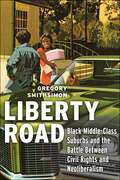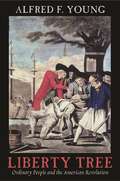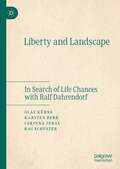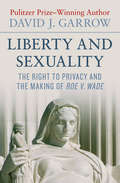- Table View
- List View
Liberated Threads: Black Women, Style, and the Global Politics of Soul (Gender and American Culture)
by Tanisha FordFrom the civil rights and Black Power era of the 1960s through antiapartheid activism in the 1980s and beyond, black women have used their clothing, hair, and style not simply as a fashion statement but as a powerful tool of resistance. Whether using stiletto heels as weapons to protect against police attacks or incorporating African-themed designs into everyday wear, these fashion-forward women celebrated their identities and pushed for equality.In this thought-provoking book, Tanisha C. Ford explores how and why black women in places as far-flung as New York City, Atlanta, London, and Johannesburg incorporated style and beauty culture into their activism. Focusing on the emergence of the "soul style" movement--represented in clothing, jewelry, hairstyles, and more--Liberated Threads shows that black women's fashion choices became galvanizing symbols of gender and political liberation. Drawing from an eclectic archive, Ford offers a new way of studying how black style and Soul Power moved beyond national boundaries, sparking a global fashion phenomenon. Following celebrities, models, college students, and everyday women as they moved through fashion boutiques, beauty salons, and record stores, Ford narrates the fascinating intertwining histories of Black Freedom and fashion.
Liberating Abortion: Claiming Our History, Sharing Our Stories, and Building the Reproductive Future We Deserve
by Renee Bracey Sherman Regina MahoneA galvanizing history of abortion recentering people of color to put forth a timely argument that we must liberate abortion for all.People of color have been having abortions since the dawn of time, yet our access is continuously under attack. In Liberating Abortion, award-winning abortion activist Renee Bracey Sherman and journalist Regina Mahone illustrate the long racist history that brought us to this moment, uncover the hidden figures who set the foundation activists and storytellers are building on today, and explain how abortion has been and remains essential to the health of our communities.Liberating Abortion will take you back to the basics of sex education, detailing the traditions of abortion over centuries , while examining how society makes us feel about our experiences. You’ll find rigorous research, never-before-heard stories, and eye-opening interviews with over 50 people of color who’ve had abortions, including activists, actresses, television writers, politicians, and the two Black members of Jane, the Chicago feminist service that provided abortions before Roe. With poignant storytelling and precise analysis, Liberating Abortion will change how you think about abortion forever.
Liberating Culture: Cross-Cultural Perspectives on Museums, Curation and Heritage Preservation (Museum Meanings)
by Christina KrepsUsing examples of indigenous models from Indonesia, the Pacific, Africa and native North America, Christina Kreps illustrates how the growing recognition of indigenous curation and concepts of cultural heritage preservation is transforming conventional museum practice. Liberating Culture explores the similarities and differences between Western and non-Western approaches to objects, museums, and curation, revealing how what is culturally appropriate in one context may not be in another. For those studying museum culture across the world, this book is essential reading.
Liberating Economics, Second Edition: Feminist Perspectives on Families, Work, and Globalization
by Susan F. Feiner Suzanne Bergeron Drucilla BarkerIn this brand-new critical analysis of economics, Barker, Bergeron, and Feiner provide a feminist understanding of the economic processes that shape households, labor markets, globalization, and human well-being to reveal the crucial role that gender plays in the economy today. With all new and updated chapters, the second edition of Liberating Economics examines recent trends in inequality, global indebtedness, crises of care, labor precarity, and climate change. Taking an interdisciplinary and intersectional feminist approach, the new edition places even more emphasis on the ways that gender, race, class, sexuality, and nationality shape the economy. It also highlights the centrality of social reproduction in economic systems and makes connections between the economic circumstances of women in global North and global South. Throughout, the authors reject the idea that there is no alternative to our current neoliberal market economy and offer alternative ways of thinking about and organizing economic systems in order to achieve gender-equitable outcomes. Written in an accessible and engaging style, this book will be of interest to students and scholars across a range of fields, policymakers, and any reader interested in creating just futures.
Liberating Fat Bodies: Social Media Censorship and Body Size Activism
by Wesley R. Bishop Bessie N. RigakosUsing a multidisciplinary and intersectional approach, this book explores the social factors that influence the ways in which societal norms police fat bodies. Chapters examine the racist and colonial constructions of Western beauty norms as well as the evolution of anti-fat bias and fat liberation, before delving into the relationship between social media and body size activism, with a particular emphasis on social media companies censoring fat people. The authors draw on first-person narratives of artists, activists, and fat social media users to unpack how, these mostly women, have used their bodies to transform the negative social perceptions of fat people. This book will be of interest to scholars and students in Sociology, Gender Studies, History, and Media Studies who research body size activism and beauty norms.
Liberating Hollywood: Women Directors and the Feminist Reform of 1970s American Cinema
by Maya SmuklerLiberating Hollywood examines the professional experiences and creative output of women filmmakers during a unique moment in history when the social justice movements that defined the 1960s and 1970s challenged the enduring culture of sexism and racism in the U.S. film industry. Throughout the 1970s feminist reform efforts resulted in a noticeable rise in the number of women directors, yet at the same time the institutionalized sexism of Hollywood continued to create obstacles to closing the gender gap. Maya Montañez Smukler reveals that during this era there were an estimated sixteen women making independent and studio films: Penny Allen, Karen Arthur, Anne Bancroft, Joan Darling, Lee Grant, Barbara Loden, Elaine May, Barbara Peeters, Joan Rivers, Stephanie Rothman, Beverly Sebastian, Joan Micklin Silver, Joan Tewkesbury, Jane Wagner, Nancy Walker, and Claudia Weill. Drawing on interviews conducted by the author, Liberating Hollywood is the first study of women directors within the intersection of second wave feminism, civil rights legislation, and Hollywood to investigate the remarkable careers of these filmmakers during one of the most mythologized periods in American film history.
Liberating Minds: The Case for College in Prison
by Ellen Condliffe LagemannAn authoritative and thought-provoking argument for offering free college in prisons—from the former dean of the Harvard Graduate School of Education. Anthony Cardenales was a stickup artist in the Bronx before spending seventeen years in prison. Today he is a senior manager at a recycling plant in Westchester, New York. He attributes his ability to turn his life around to the college degree he earned in prison. Many college-in-prison graduates achieve similar success and the positive ripple effects for their families and communities, and for the country as a whole, are dramatic. College-in-prison programs have been shown to greatly reduce recidivism. They increase post-prison employment, allowing the formerly incarcerated to better support their families and to reintegrate successfully into their communities. College programs also decrease violence within prisons, improving conditions for both correction officers and the incarcerated. Liberating Minds eloquently makes the case for these benefits and also illustrates them through the stories of formerly incarcerated college students. As the country confronts its legacy of over-incarceration, college-in-prison provides a corrective on the path back to a more democratic and humane society. &“Lagemann includes intensive research, but her most powerful supporting evidence comes from the anecdotes of former prisoners who have become published poets, social workers, and nonprofit leaders.&”—Publishers Weekly
Liberating Rites: Understanding The Transformative Power Of Ritual
by Tom F. DriverThis book shows how necessary ritual is to human freedom and to social processes of liberation. It aims to reflect upon the deep human longing for ritual and to interpret it in the light of our physical, social, political, sexual, moral, aesthetic, and religious existence. .
Liberating Sápmi: Indigenous Resistance in Europe's Far North
by Gabriel KuhnThe Sámi, who have inhabited Europe's far north for thousands of years, are often referred to as the continent's "forgotten people." With Sápmi, their traditional homeland, divided between four nation-states—Norway, Sweden, Finland, and Russia—the Sámi have experienced the profound oppression and discrimination that characterize the fate of indigenous people worldwide: their lands have been confiscated, their beliefs and values attacked, their communities and families torn apart. Yet the Sámi have shown incredible resilience, defending their identity and their territories and retaining an important social and ecological voice—even if many, progressives and leftists included, refuse to listen. Liberating Sápmi is a stunning journey through Sápmi and includes in-depth interviews with Sámi artists, activists, and scholars boldly standing up for the rights of their people. In this beautifully illustrated work, Gabriel Kuhn, author of over a dozen books and our most fascinating interpreter of global social justice movements, aims to raise awareness of the ongoing fight of the Sámi for justice and self-determination. The first accessible English-language introduction to the history of the Sámi people and the first account that focuses on their political resistance, this provocative work gives irrefutable evidence of the important role the Sámi play in the resistance of indigenous people against an economic and political system whose power to destroy all life on earth has reached a scale unprecedented in the history of humanity. The book contains interviews with Mari Boine, Harald Gaski, Ann-Kristin Håkansson, Aslak Holmberg, Maxida Märak, Stefan Mikaelsson, May-Britt Öhman, Synnøve Persen, Øyvind Ravna, Niillas Somby, Anders Sunna, and Suvi West.
Liberation Ecologies: Environment, Development and Social Movements
by Richard Peet Michael WattsLiberation Ecologies brings together some of the most exciting theorists in the field to explore the impact of political ecology in today's developing world. The book casts new light on the crucial interrelations of development, social movements and the environment in the South - the 'bigger' half of our planet - and raises questions and hopes about change on the global scale. The in-depth case material is drawn from across the Developing World, from Latin America, Africa and Asia. The issues raised in contemporary political, economic and social theory are illustrated through these case studies. Ultimately, Liberation Ecologies questions what we understand by 'development', be it mainstream or alternative, and seeks to renew our sense of nature's range of possibilities.
Liberation Is Here: Women Uncovering Hope in a Broken World
by Nikole LimAs a freelance filmmaker, Nikole Lim's career allowed her to step in and out of the lives of marginalized people around the world. But when confronted with the prevalence of sexual violence in Kenyan and Zambian communities, she commits to advocating alongside the courageous survivors whose lives have intersected with hers. These women's powerful stories inspire her to embark on a new vocation, partnering with survivors of sexual violence to launch a nonprofit organization that equips women to lead through the rewritten stories of their lives. But as Lim seeks to help her friends experience healing and liberation, her perspective is altered. Spiritually depleted, she finds herself ministered to by the women she came to serve—the once oppressed become her liberators. Illustrated with dramatic full-color photography from Lim's own camera, Liberation Is Here transports us to forgotten corners of the world. From the slums of Nairobi, hospitals of Lusaka, killing fields of Kigali, and the back alleys of Barcelona, Lim weaves together a narrative of God’s grace and healing amid fear and trauma. Her journey proves that liberation is not just near, but it is here—in the eyes of the broken, the hearts of the oppressed, and the untold stories of our global community.
Liberation Memories: The Rhetoric and Poetics of John Oliver Killens
by Keith GilyardNo serious history of the development of the African American novel from the 1950s onward can be written without reference to John Oliver Killens. A two-time nominee for the Pulitzer Prize and founding chairman of the legendary Harlem Writers Guild, Killens was regarded by many as a spiritual father who inspired a generation of African American novelists with his politically charged works. And yet today he rarely receives proper critical attention. Seeking to strengthen our understanding of this important literary figure, Keith Gilyard departs from standard critical frameworks to reveal Killens's novels as artful renderings of rich African American rhetorical forms and verbal traditions. Gilyard finds that many critics, adhering to ideals of art for art's sake or narrative conciseness, are ill-equipped to appreciate the many ways in which Killens's fiction succeeds. Rejecting the "pure art" position, Killens sought to articulate Black heroism particularly within a family or community context, offering a set of values he deemed liberatory. He focused on rendering noble and polemical characters, and his work represents a distinguished fusion of sociopolitical persuasion (rhetoric) and literary artifact (poetics). To help illuminate such novels as Youngblood (1954), And Then We Heard the Thunder (1962), and The Cotillion (1971), Gilyard examines Killens's work as an essayist and cultural organizer, highlighting his activism. His life and literary production can be partly characterized, Gilyard suggests, by the African American jeremiad--a major rhetorical form in the Black intellectual tradition expressing faith that America's destiny is to become an authentic, pluralistic democracy.
Liberation Sociology
by Joe R. Feagin Hernan VeraLiberation sociology is concerned with eliminating social oppressions and creating truly just societies. Liberation sociology takes sides with the oppressed and envisions an end to that oppression. Liberation social scientists featured in this book consciously try to step outside their groups or societies and view them critically. The authors examine theories and research of social scientists who ask, Social science for what purpose? and Social science for whom? Case studies offer humanistic, democratic, and activist answers. Featured researchers provide tools to increase human abilities to understand deep social realities, engage in better dialogues, and increase democratic participation in use of knowledge.Many people of all ages today continue to be attracted to sociology and other social sciences because of their promise to contribute to better political, social, and moral understandings of themselves and their social worlds-and often because they hope it will help them to build a better society. We accent the liberation potential of social science with these social science teachers and students firmly in mind.
Liberation Technology: Social Media and the Struggle for Democracy (A Journal of Democracy Book)
by Larry Diamond and Marc F. PlattnerThe revolutions sweeping the Middle East provide dramatic evidence of the role that technology plays in mobilizing citizen protest and upending seemingly invulnerable authoritarian regimes. A grainy cell phone video of a Tunisian street vendor’s self-immolation helped spark the massive protests that toppled longtime ruler Zine El Abidine Ben Ali, and Egypt’s "Facebook revolution" forced the ruling regime out of power and into exile. While such "liberation technology" has been instrumental in freeing Egypt and Tunisia, other cases—such as China and Iran—demonstrate that it can be deployed just as effectively by authoritarian regimes seeking to control the Internet, stifle protest, and target dissenters. This two-sided dynamic has set off an intense technological race between "netizens" demanding freedom and authoritarians determined to retain their grip on power.Liberation Technology brings together cutting-edge scholarship from scholars and practitioners at the forefront of this burgeoning field of study. An introductory section defines the debate with a foundational piece on liberation technology and is then followed by essays discussing the popular dichotomy of "liberation" versus "control" with regard to the Internet and the sociopolitical dimensions of such controls. Additional chapters delve into the cases of individual countries: China, Egypt, Iran, and Tunisia.This book also includes in-depth analysis of specific technologies such as Ushahidi—a platform developed to document human-rights abuses in the wake of Kenya’s 2007 elections—and alkasir—a tool that has been used widely throughout the Middle East to circumvent cyber-censorship.Liberation Technology will prove an essential resource for all students seeking to understand the intersection of information and communications technology and the global struggle for democracy.Contributors: Walid Al-Saqaf, Daniel Calingaert, Ronald Deibert, Larry Diamond, Elham Gheytanchi, Philip N. Howard, Muzammil M. Hussain, Rebecca MacKinnon, Patrick Meier, Evgeny Morozov, Xiao Qiang, Rafal Rohozinski, Mehdi Yahyanejad
Liberation Theologies, Postmodernity and the Americas
by David Batstone Eduardo Mendieta Dwight N. Hopkins Lois Ann LorentzeFirst Published in 1997. Routledge is an imprint of Taylor & Francis, an informa company.
Liberazione Della Donna: Feminism in Italy
by Lucia C. BirnbaumA survey of the history and modern transformation of the Italian feminist movement.
Liberia
by Mary H. MoranLiberia, a small West African country that has been wracked by violence and civil war since 1989, seems a paradoxical place in which to examine questions of democracy and popular participation. Yet Liberia is also the oldest republic in Africa, having become independent in 1847 after colonization by an American philanthropic organization as a refuge for "Free People of Color" from the United States. Many analysts have attributed the violent upheaval and state collapse Liberia experienced in the 1980s and 1990s to a lack of democratic institutions and long-standing patterns of autocracy, secrecy, and lack of transparency. Liberia: The Violence of Democracy is a response, from an anthropological perspective, to the literature on neopatrimonialism in Africa.Mary H. Moran argues that democracy is not a foreign import into Africa but that essential aspects of what we in the West consider democratic values are part of the indigenous African traditions of legitimacy and political process. In the case of Liberia, these democratic traditions include institutionalized checks and balances operating at the local level that allow for the voices of structural subordinates (women and younger men) to be heard and be effective in making claims. Moran maintains that the violence and state collapse that have beset Liberia and the surrounding region in the past two decades cannot be attributed to ancient tribal hatreds or neopatrimonial leaders who are simply a modern version of traditional chiefs. Rather, democracy and violence are intersecting themes in Liberian history that have manifested themselves in numerous contexts over the years.Moran challenges many assumptions about Africa as a continent and speaks in an impassioned voice about the meanings of democracy and violence within Liberia.
Liberia, South Carolina: An African American Appalachian Community (H. Eugene and Lillian Youngs Lehman Series)
by John M. CoggeshallIn 2007, while researching mountain culture in upstate South Carolina, anthropologist John M. Coggeshall stumbled upon the small community of Liberia in the Blue Ridge foothills. There he met Mable Owens Clarke and her family, the remaining members of a small African American community still living on land obtained immediately after the Civil War. This intimate history tells the story of five generations of the Owens family and their friends and neighbors, chronicling their struggles through slavery, Reconstruction, the Jim Crow era, and the desegregation of the state. Through hours of interviews with Mable and her relatives, as well as friends and neighbors, Coggeshall presents an ethnographic history that allows members of a largely ignored community to speak and record their own history for the first time. This story sheds new light on the African American experience in Appalachia, and in it Coggeshall documents the community's 150-year history of resistance to white oppression, while offering a new way to understand the symbolic relationship between residents and the land they occupy, tying together family, memory, and narratives to explain this connection.
Libertarian Literary and Media Criticism: Essays in Memory of Paul A. Cantor
by Jo Ann CavalloThis volume applies libertarian philosophy and free-market economic theory to both literature and media, from early modern drama to novels to comic books, cinema, and television series. Several chapters contrast capitalism with statism, focusing on the market economy versus central planning, freedom versus government coercion. Not surprisingly, the economic theories of Adam Smith, Ludwig von Mises, and F.A. Hayek run through several essays. Contributors also engage with other theorists and writers as diverse as Thomas Hobbes, Charles Darwin, Thomas Huxley, Friedrich Nietzsche, Leo Strauss, and Judith Butler.
Liberty Equality Fashion: The Women Who Styled the French Revolution
by Anne HigonnetThree women led a fashion revolution and turned themselves into international style celebrities. Joséphine Bonaparte, future Empress of France; Térézia Tallien, the most beautiful woman in Europe; and Juliette Récamier, muse of intellectuals, had nothing left to lose. After surviving incarceration and forced incestuous marriage during the worst violence of the French Revolution of 1789, they dared sartorial revolt. Together, Joséphine and Térézia shed the underwear cages and massive, rigid garments that women had been obliged to wear for centuries. They slipped into light, mobile dresses, cropped their hair short, wrapped themselves in shawls, and championed the handbag. Juliette made the new style stand for individual liberty. The erotic audacity of these fashion revolutionaries conquered Europe, starting with Napoleon. Everywhere a fashion magazine could reach, women imitated the news coming from Paris. It was the fastest and most total change in clothing history. Two centuries ahead of its time, it was rolled back after only a decade by misogynist rumors of obscene extravagance. New evidence allows the real fashion revolution to be told. This is a story for our time: of a revolution that demanded universal human rights, of self-creation, of women empowering each other, and of transcendent glamor
Liberty Hyde Bailey: Essential Agrarian and Environmental Writings
by Liberty Hyde Bailey"Nature-study not only educates, but it educates nature-ward; and nature is ever our companion, whether we will or no. Even though we are determined to shut ourselves in an office, nature sends her messengers. The light, the dark, the moon, the cloud, the rain, the wind, the falling leaf, the fly, the bouquet, the bird, the cockroach-they are all ours. If one is to be happy, he must be in sympathy with common things. He must live in harmony with his environment. One cannot be happy yonder nor tomorrow: he is happy here and now, or never. Our stock of knowledge of common things should be great. Few of us can travel. We must know the things at home."—from "The Meaning of the Nature-study Movement""To feel that one is a useful and cooperating part in nature is to give one kinship, and to open the mind to the great resources and the high enthusiasms. Here arise the fundamental common relations. Here arise also the great emotions and conceptions of sublimity and grandeur, of majesty and awe, the uplift of vast desires—when one contemplates the earth and the universe and desires to take them into the soul and to express oneself in their terms; and here also the responsible practices of life take root."—from The Holy EarthBefore Wendell Berry and Aldo Leopold, there was the horticulturalist and botanist Liberty Hyde Bailey (1858–1954). For Wendell Berry, Bailey was a revelation, a symbol of the nature-minded agrarianism Berry himself popularized. For Aldo Leopold, Bailey offered a model of the scholar-essayist-naturalist. In his revolutionary work of eco-theology, The Holy Earth, Bailey challenged the anthropomorphism—the people-centeredness—of a vulnerable world. A trained scientist writing in the lyrical tradition of Emerson, Burroughs, and Muir, Bailey offered the twentieth century its first exquisitely interdisciplinary biocentric worldview; this Michigan farmer's son defined the intellectual and spiritual foundations of what would become the environmental movement.For nearly a half century, Bailey dominated matters agricultural, environmental, and scientific in the United States. He worked both to improve the lives of rural folk and to preserve the land from which they earned their livelihood. Along the way, he popularized nature study in U.S. classrooms, lobbied successfully for women's rights on and off the farm, and bulwarked Teddy Roosevelt's pioneering conservationism.Here for the first time is an anthology of Bailey's most important writings suitable for the general and scholarly reader alike. Carefully selected and annotated by Zachary Michael Jack, this book offers a comprehensive introduction to Bailey's celebrated and revolutionary thinking on the urgent environmental, agrarian, educational, and ecospiritual dilemmas of his day and our own. Culled from ten of Bailey's most influential works, these lyrical selections highlight Bailey's contributions to the nature-study and the Country Life movements. Published on the one-hundredth anniversary of Bailey's groundbreaking report on behalf of the Country Life Commission, Liberty Hyde Bailey: Essential Agrarian and Environmental Writings will inspire a new generation of nature writers, environmentalists, and those who share with Bailey a profound understanding of the elegance and power of the natural world and humanity's place within it.
Liberty Road: Black Middle-Class Suburbs and the Battle Between Civil Rights and Neoliberalism
by Gregory SmithsimonA unique insight into desegregation in the suburbs and how racial inequality persists Half of Black Americans who live in the one hundred largest metropolitan areas are now living in suburbs, not cities. In Liberty Road, Gregory Smithsimon shows us how this happened, and why it matters, unearthing the hidden role that suburbs played in establishing the Black middle-class. Focusing on Liberty Road, a Black middle-class suburb of Baltimore, Smithsimon tells the remarkable story of how residents broke the color barrier, against all odds, in the face of racial discrimination, tensions with suburban whites and urban Blacks, and economic crises like the mortgage meltdown of 2008. Drawing on interviews, census data, and archival research he shows us the unique strategies that suburban Black residents in Liberty Road employed, creating a blueprint for other Black middle-class suburbs. Smithsimon re-orients our perspective on race relations in American life to consider the lived experiences and lessons of those who broke the color barrier in unexpected places. Liberty Road shows us that if we want to understand Black America in the twenty-first century, we must look not just to our cities, but to our suburbs as well.
Liberty Tree: Ordinary People and the American Revolution
by Alfred F YoungThe renowned historian offers a &“subtle, complex, and bold&” reassessment of the American Revolution in this acclaimed essay collection (Howard Zinn, author of A People&’s History of the United States). In Liberty Tree, Alfred F. Young presents a selection of his seminal writing as well as two provocative, never-before-published essays. Together, they take the reader on a journey through the American Revolution, exploring the role played by ordinary women and men (called, at the time, people out of doors) in shaping events during and after the Revolution, their impact on the Founding generation of the new American nation, and finally how this populist side of the Revolution has fared in public memory. Drawing on a wide range of sources, which include not only written documents but also material items like powder horns, and public rituals like parades and tarring and featherings, Young places ordinary Americans at the center of the Revolution. Moreover, Young interrogates standard historical narratives through close examination of Revolutionary icons, such as the pamphleteer Thomas Paine and Boston's Freedom Trail. For decades, Young's path-breaking work has shed light on ordinary people of the Revolutionary era, seamlessly blending sophisticated analysis with compelling prose. From his award-winning work on mechanics, or artisans, in the seaboard cities of the Northeast to the all but forgotten liberty tree, a major popular icon of the Revolution explored in depth for the first time, Young continues to astound readers as he forges new directions in the history of the American Revolution.
Liberty and Landscape: In Search of Life Chances with Ralf Dahrendorf
by Olaf Kühne Corinna Jenal Karsten Berr Kai SchusterThis book explores the importance of freedom and liberalism in the context of socialities, individualities and materialities. The authors provide a highly unusual and innovative blending of concepts about space and landscape through a deeply theoretical exploration of liberalism.Liberalism is often problematized in contemporary discussions with regard to gentrification, environmental problems and inequality. In contrast, this book refers to a liberalism that maximizes life chances in the context of dealing with spaces. A connection between freedom and space, based on liberal ideas, provides a much needed theoretical intervention in the fields of social and spatial sciences.
Liberty and Sexuality: The Right to Privacy and the Making of Roe v. Wade
by David J. GarrowPulitzer Prize-winning author David J. Garrow's stirring and essential history of the politics of abortion and America's battle for the right to choose In 1973, the Supreme Court handed down its landmark Roe v. Wade decision legalizing abortion, and more than forty years later the issue continues to spark controversy and divisiveness. But behind this historic legal case lie the battles women fought to establish their rights to use contraceptives and choose to have an abortion. Liberty and Sexuality traces these political and legal struggles in the decades leading up to Roe v. Wade--including the momentous 1965 Supreme Court ruling in Griswold v. Connecticut that established a constitutional "right to privacy." Garrow personalizes the struggles by detailing the vital contributions made by dozens of crusaders who tirelessly paved the way. This expansive and substantial work also addresses the threats to sexual privacy and the legality of abortion that have risen since Roe v. Wade. With abortion still a contentious subject on the national political landscape, Liberty and Sexuality is not just a historical account of the right to choose, but an indispensable read about preserving a freedom that continues to divide America.
